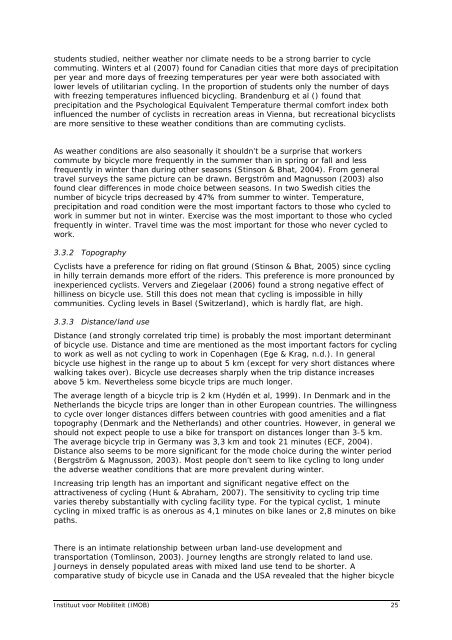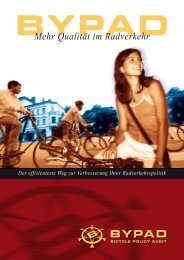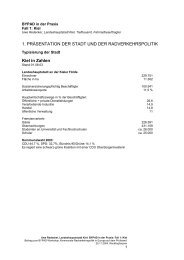Annex I: Literature search bicycle use and influencing ... - ByPAD
Annex I: Literature search bicycle use and influencing ... - ByPAD
Annex I: Literature search bicycle use and influencing ... - ByPAD
Create successful ePaper yourself
Turn your PDF publications into a flip-book with our unique Google optimized e-Paper software.
students studied, neither weather nor climate needs to be a strong barrier to cycle<br />
commuting. Winters et al (2007) found for Canadian cities that more days of precipitation<br />
per year <strong>and</strong> more days of freezing temperatures per year were both associated with<br />
lower levels of utilitarian cycling. In the proportion of students only the number of days<br />
with freezing temperatures influenced bicycling. Br<strong>and</strong>enburg et al () found that<br />
precipitation <strong>and</strong> the Psychological Equivalent Temperature thermal comfort index both<br />
influenced the number of cyclists in recreation areas in Vienna, but recreational bicyclists<br />
are more sensitive to these weather conditions than are commuting cyclists.<br />
As weather conditions are also seasonally it shouldn’t be a surprise that workers<br />
commute by <strong>bicycle</strong> more frequently in the summer than in spring or fall <strong>and</strong> less<br />
frequently in winter than during other seasons (Stinson & Bhat, 2004). From general<br />
travel surveys the same picture can be drawn. Bergström <strong>and</strong> Magnusson (2003) also<br />
found clear differences in mode choice between seasons. In two Swedish cities the<br />
number of <strong>bicycle</strong> trips decreased by 47% from summer to winter. Temperature,<br />
precipitation <strong>and</strong> road condition were the most important factors to those who cycled to<br />
work in summer but not in winter. Exercise was the most important to those who cycled<br />
frequently in winter. Travel time was the most important for those who never cycled to<br />
work.<br />
3.3.2 Topography<br />
Cyclists have a preference for riding on flat ground (Stinson & Bhat, 2005) since cycling<br />
in hilly terrain dem<strong>and</strong>s more effort of the riders. This preference is more pronounced by<br />
inexperienced cyclists. Ververs <strong>and</strong> Ziegelaar (2006) found a strong negative effect of<br />
hilliness on <strong>bicycle</strong> <strong>use</strong>. Still this does not mean that cycling is impossible in hilly<br />
communities. Cycling levels in Basel (Switzerl<strong>and</strong>), which is hardly flat, are high.<br />
3.3.3 Distance/l<strong>and</strong> <strong>use</strong><br />
Distance (<strong>and</strong> strongly correlated trip time) is probably the most important determinant<br />
of <strong>bicycle</strong> <strong>use</strong>. Distance <strong>and</strong> time are mentioned as the most important factors for cycling<br />
to work as well as not cycling to work in Copenhagen (Ege & Krag, n.d.). In general<br />
<strong>bicycle</strong> <strong>use</strong> highest in the range up to about 5 km (except for very short distances where<br />
walking takes over). Bicycle <strong>use</strong> decreases sharply when the trip distance increases<br />
above 5 km. Nevertheless some <strong>bicycle</strong> trips are much longer.<br />
The average length of a <strong>bicycle</strong> trip is 2 km (Hydén et al, 1999). In Denmark <strong>and</strong> in the<br />
Netherl<strong>and</strong>s the <strong>bicycle</strong> trips are longer than in other European countries. The willingness<br />
to cycle over longer distances differs between countries with good amenities <strong>and</strong> a flat<br />
topography (Denmark <strong>and</strong> the Netherl<strong>and</strong>s) <strong>and</strong> other countries. However, in general we<br />
should not expect people to <strong>use</strong> a bike for transport on distances longer than 3-5 km.<br />
The average <strong>bicycle</strong> trip in Germany was 3,3 km <strong>and</strong> took 21 minutes (ECF, 2004).<br />
Distance also seems to be more significant for the mode choice during the winter period<br />
(Bergström & Magnusson, 2003). Most people don’t seem to like cycling to long under<br />
the adverse weather conditions that are more prevalent during winter.<br />
Increasing trip length has an important <strong>and</strong> significant negative effect on the<br />
attractiveness of cycling (Hunt & Abraham, 2007). The sensitivity to cycling trip time<br />
varies thereby substantially with cycling facility type. For the typical cyclist, 1 minute<br />
cycling in mixed traffic is as onerous as 4,1 minutes on bike lanes or 2,8 minutes on bike<br />
paths.<br />
There is an intimate relationship between urban l<strong>and</strong>-<strong>use</strong> development <strong>and</strong><br />
transportation (Tomlinson, 2003). Journey lengths are strongly related to l<strong>and</strong> <strong>use</strong>.<br />
Journeys in densely populated areas with mixed l<strong>and</strong> <strong>use</strong> tend to be shorter. A<br />
comparative study of <strong>bicycle</strong> <strong>use</strong> in Canada <strong>and</strong> the USA revealed that the higher <strong>bicycle</strong><br />
Instituut voor Mobiliteit (IMOB) 25




